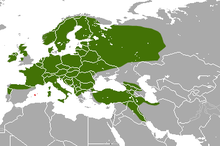Pine marten
| European pine marten | |
|---|---|
 |
|
| Scientific classification | |
| Kingdom: | Animalia |
| Phylum: | Chordata |
| Class: | Mammalia |
| Order: | Carnivora |
| Family: | Mustelidae |
| Genus: | Martes |
| Species: | M. martes |
| Binomial name | |
|
Martes martes (Linnaeus, 1758) |
|
 |
|
| European pine marten range (green – native, red – introduced) |
|
The European pine marten (Martes martes), known most commonly as the pine marten in Anglophone Europe, and less commonly also known as pineten, baum marten, or sweet marten, is an animal native to Northern Europe belonging to the mustelid family, which also includes mink, otter, badger, wolverine and weasel.
The body is up to 53 cm (21 in) in length, and its bushy tail can be 25 cm (10 in). Males are slightly larger than females; on average a marten weighs around 1.5 kg (3.3 lb). Their fur is usually light to dark brown and grows longer and silkier during the winter months. They have a cream to yellow coloured "bib" marking on their throats.
Their habitats are usually well-wooded areas. European pine martens usually make their own dens in hollow trees or scrub-covered fields. Martens are the only mustelids with semi-retractable claws. This enables them to lead more arboreal lifestyles, such as climbing or running on tree branches, although they are also relatively quick runners on the ground. They are mainly active at night and dusk. They have small rounded, highly sensitive ears and sharp teeth adapted for eating small mammals, birds, insects, frogs, and carrion. They have also been known to eat berries, birds' eggs, meat, nuts and honey. European pine martens are territorial animals that mark their range by depositing faeces (called 'scats') in prominent locations. These scats are black and twisted and can be confused with those of the fox, except that they reputedly have a floral odour.
Although they are preyed upon occasionally by golden eagles, red foxes, wolves and wildcats, humans are the largest threat to pine martens. They are vulnerable from conflict with humans, arising from predator control for other species, or following predation of livestock and the use of inhabited buildings for denning. Martens may also be affected by woodland loss. Persecution (illegal poisoning and shooting) by gamekeepers, loss of habitat leading to fragmentation, and other human disturbance have caused a considerable decline in the pine marten population. They are also prized for their very fine fur in some areas. In the United Kingdom, European pine martens and their dens are offered full protection under the Wildlife and Countryside Act 1981 and the Environmental Protection Act 1990.
...
Wikipedia

